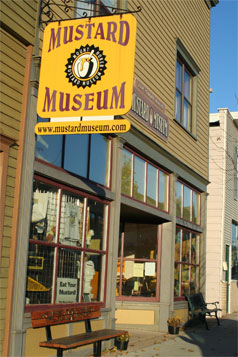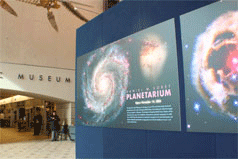

More alternatives:
Museum Throwdown
Head under the big top, don't pass the mustard; Wisconsin historical collections face off
 |
|
With a collection of more than 4,000 mustards. The Mustard Museum is the undisputed champ of obscure museum collections. Photo courtesy of Anne Shapiro |
Calling all gymphobics
Don't fancy dumbbells and treadmills? Try getting your fitness fix with these alternatives
Musical cup of comfort
Bremen Cafe hidden entertainment gem of Milwaukee's Riverwest
By Joe Hasler
When I was growing up, my family never took tropical vacations. Instead of going on cruises or visiting Disneyland, my parents dragged my brother and me around on what I can only describe as “academic” vacations. Our destinations included the Civil War battlefields of Northern Virginia, Mark Twain’s hometown in Missouri and the historical sites of Boston. Naturally, there were museum stops too. We hit the Louvre in Paris, the Field Museum in Chicago and every single stinking building with the name Smithsonian on it in Washington, D.C.
Back in school after vacations, when the time came to recount how I spent my leisure time, my classmates usually responded with confused faces and stinging insults like, “What a loser. I can’t believe you went to a museum!” or “My parents would never make me learn on vacation.” I didn’t let it get to me though, and over my 22 years of existence, I’ve fostered a healthy fondness for museums. Living in Wisconsin that whole time hasn’t hurt either. You might not expect it, but the Badger State boasts a staggering array of museums, four of which I’ve made into a little thing I like to call the Wisconsin Museum Throwdown.
Obscure Collection Throwdown: Circus World Museum v. Mount Horeb Mustard Museum
Historical Museum Throwdown: Milwaukee Public Museum v. Old World Wisconsin
_____________________________________________
Obscure Collection Throwdown: Circus World Museum v. Mount Horeb Mustard Museum
Nestled between Mount Horeb Plumbing Inc. and an Edward Jones office in downtown Mount Horeb, the Mustard Museum hardly appears worthy of a second glance, much less a stop inside. Save for an unobtrusive “Mustard Museum” sign hanging above the door, you’d hardly know it was there. As it turns out, this sign is actually the Mustard Museum’s only attempt at subtlety.
From the second I walked through the door under that sign, I realized this was like no other museum I’d ever been to before. The wall paint, which radiated with the light of a thousand suns and actually caused me to shield my face with my hand, was proof positive of that. I’m no expert in paint shades, but I’d venture a guess the local hardware store never sold so much mustard-yellow paint, the intensity of which is only magnified by racks upon racks of mustard memorabilia, most of which was yellow as well.
It was obvious the Mustard Museum doesn’t follow the conventions of the museum world. Rather than put the gift shop at the end of the tour, the Mustard Museum hits you with it right away. I arrived just before a touring coach bus from Minnesota. Most of the tourists never made it past the tasting tables in the back of the gift shop. With no fewer than six flavors to sample and an endless supply of delicious pretzels, you can’t blame them. But I soldiered on. After a brief stop at Poupon U. (America’s mustard college, of course) I wandered into the first exhibit, The MustardPiece Theatre. A group of old timers (if I had to guess, I’d say the average age of those in attendance was somewhere around 78) had actually turned their chairs away from the movie playing on a modest TV set. I tried to watch some of the movie, a documentary on the history of the condiment, but one of the Minnesotan elders kept trying to tell jokes about how cold it gets in Minnesota. (One from his repertoire: “It’s so cold in Minnesota, there’s snow in July.”) I didn’t stick around for the end of the film.
By contrast, the next room—which is actually the only other room in the museum—had a more academic feel. It was obvious a painstaking amount of research and diligence went into building the extensive collection housed here. Mustard containers from all over the world cover every single inch of wall space. The symbolism was clear. There’s no room for any other condiments here.
In the middle of the room, antique mustard jars harken to better days when people actually used mustard jars. In all, there are more than 4,200 jars, bottles and tubes in this room—an absolutely staggering statistic when you consider there isn’t a single hot dog in sight. But you’d be surprised how little space it takes for the entire collection. It might be the world’s largest collection of its sort, but it doesn’t command any more than 30 or 40 minutes or your time, even less if you skip the tasting tables.
The same can’t be said for the Circus World Museum, located just about 40 miles away in Baraboo. Circus World boasts its own equally obscure collection. According to guide and Ringmaster Dave SaLoutos, it’s home to more than two-thirds of the known circus wagons in the entire world. Now we’ve got ourselves a fight.
While I handled my tour of the Mustard Museum’s two rooms by my lonesome, there was no way I could do Circus World on my own. First of all, it’s spread across 64 acres along the meandering Baraboo River. Second of all, I didn’t want to take a wrong turn and end up in an elephant’s cage. SaLoutos assuaged one of my fears when he informed me the animals—which live in Baraboo during the circus season from May to September—head south for the winter. With the threat of death-by-elephant ruled out, I turned my attention to the splendor of the circus wagons. According to SaLoutos, Circus World has 200 wagons on the site, most of which are located in the W.W. Deppe Wagon Pavilion. Across from the pavilion though, is the C.P. Fox Wagon Restoration Center, where a man actually gets paid to spend his days buffing, sanding and painting old wagons.
The wagons used to get an annual workout at The Great Circus Parade in Milwaukee, but since that event ceased in 2003, they’ve seen only sporadic action. For two years Circus World trotted them out on the streets of Baraboo, but now even that parade is on hiatus. Without the publicity or extra funds of The Great Circus Parade, the Circus World Museum has seen some dark days. SaLoutos, who’s been with the circus for 20 years, worries it’s no longer “on people’s radar.” This was apparent during my visit. As SaLoutos guided me around the grounds we hardly encountered another soul, not even a clown, though I assume they head south for the winter too. To be fair, the main attractions at Circus World are the live shows during the summer. Even then, who honestly wants to see a shed full of ornately painted wagons when the fresh fudge and miles of waterslides (best enjoyed separately) of the Wisconsin Dells wait just ten minutes down Highway 12? SaLoutos and company certainly have their work cut out for them, but at least they’ve got the animals on their side—that is, until it gets cold.
Verdict: On paper, it doesn’t look like a fair fight. You could fit the entire Mustard Museum collection inside the women’s bathroom at the Circus World Museum. Then again, there’s a lot to be said for tasting tables and an endless supply of pretzels. And if you’re going to talk about obscure collections, consider the Mustard Museum’s display case dedicated to the relationship between mustard and baseball, or the collection of stress relieving mustard baths. Forget obscure, that’s just weird. Of course, the Circus World boasts its own unique fare. Take the Gavioli organ bandwagon for example. Like many of the other wagons, the Gavioli was found hidden in a farmer’s barn. I know, you’re wondering how anyone hid a 20-foot tall wagon with a giant organ inside of their barn; I wondered the same thing too. After actually hearing the music from the organ—imagine a compressed version of the “It’s a Small World” ride at Disneyland but with the volume magnified by about 30 decibels—I found myself wishing it would go back into exile.
Ultimately, the nod goes to the Mustard Museum for sheer numerical superiority. Having 200 shiny wagons is nice, but collecting more than 4,000 cans, bottles and jars of mustard is absolutely audacious. That anyone even contrived such a plot boggles the mind. Not only that, but like the tasting samples in the gift shop, admission to the museum is also free, which only pushes the Mustard Museum further ahead.
Now, if someone were really smart, they’d open up a hot dog museum across the street. Then we’d have a real throwdown.
______________________________________________
Historical Museum Throwdown: Milwaukee Public Museum v. Old World Wisconsin
I got lost on the way to Old World Wisconsin. I’m man enough to admit that. It’s located a few miles outside of Eagle, which really isn’t big enough to get lost in. Somehow, I managed it. I briefly considered popping into the Eagle Historical Society instead. Fortunately, the wonderful cashier at the BP gas station pointed me in the right direction. I was off schedule but back on track.
Tucked deep in the woods of Waukesha County, just off Highway 67, Old World Wisconsin’s setting has a sort of pristine, natural quality that makes you wonder why the State Historical Society—which runs the place—hasn’t turned it into a destination spa yet. It takes up 600 acres spread across the southern tip of Kettle Moraine State Forest, and as I would find out later, it would take no fewer than five hours to see everything.
My wrong turn in Eagle left me a bit behind schedule. When I arrived at 3:30 p.m., a sign informed me I had 30 minutes until closing time. Distressed, I ran to the ticket booth, only to find it was locked for the evening. Doing what anyone else in my situation would do, I disregarded the “Wristbands must be worn beyond this point” and slipped through the unmanned entry gate. My timing was impeccable too, as just seconds later a tram car arrived to whisk me into the world’s largest museum of historic rural life.
Our first stop was the latrine. Nobody got off. We had things to see. There were a few families on the tram with me, and all the little girls were wearing Laura Ingalls Wilder style costumes. I crossed my fingers that the gift shop would still be open when we finished so I could get one for myself. But before I could worry about the gift shop, there was a living history museum to see. After a short ride from the bathrooms, we arrived at the Schottler family farm located in German area. (The museum is separated into several areas, with each one representing a different group that settled Wisconsin during the 19th and early 20th centuries.) Here I found Barb Maus, an interpreter (like a Civil War re-enactor, but less drunk and without the beard) running from the homestead’s smoke house to the kitchen. I wondered if she was preparing some sort of Old World cuisine for dinner. She was actually just locking up for the night.
Around the corner at the Schulz farm, another German settlement, I found a little more action. While a pair of enormous oxen had distracted the Little House wannabes outside, the other tourists watched an interpreter spin flax inside. I opted to listen in on a description of 18th Century roof-thatching techniques at the back barn. But before the interpreter could get to the good stuff, he stopped and yelled to the little Lauras “be careful around those oxen. They’re docile by nature, but if you get too close they’re dangerous.” It was about time I learned something interesting.
Four o’clock came quickly, and the last tram arrived soon after. I’d managed to see the German and Polish settlements, and I caught a brief glimpse of the Caldwell Farmers Club Hall. Still unseen were countless other areas, including the Crossroads Village, the Norwegian area (Barb’s favorite) and the Yankee Farm settlement. Worse yet, the gift shop was closed when the tram got back to the entrance.
I had no such time constraints when I visited the Milwaukee Public Museum. It’s a good thing because there’s just as much to see there, and not a single two-ton oxen or roof-thatching discussion in sight. Instead of actual people and livestock, the Milwaukee Public Museum uses a less-living, more life-like diorama approach. In 1890, taxidermist/biologist/conservationist Carl Akeley created the first museum habitat diorama. Since Akeley unveiled his true-to-life muskrat lair there—and in the process created what museum ilk call “the Milwaukee style”—the Milwaukee Public Museum hasn’t looked back.
They’ve applied the Milwaukee style all over the place and dioramas dominate landscape. Most of them are behind glass, but that doesn’t make exhibits like “The Living Sea,” with its dim lighting and giant sharks, any less creepy. Also poorly lit is the “Streets of Old Milwaukee” exhibit. This is a diorama you can actually walk into. I’d advise doing so with caution, as the uneven cobblestones pose a serious safety hazard. Fortunately, the rock candy in the dime candy store is worth the trouble. If you’re more into the interactive experience, there’s the Puelicher Butterfly Wing, where butterflies actually flutter around. If you stand still, they’ll land right on your face. Frankly, I find that a bit terrifying, but my guide assured me kids love it.
The tour guide also told me about the “snake button” at the buffalo hunt diorama in the North American Indian exhibit. In fact, she got me pretty excited about that dang button. Apparently, there’s a hidden button that when pressed prompts a seemingly inanimate snake to rattle it’s tail. I say “apparently” because we looked for about five minutes and couldn’t find the button anywhere. Later, as I left the museum, I saw “I Pushed the Snake Button at the Milwaukee Public Library” T-shirts in the gift shop, so it must be real. I guess finding that button is as good a reason as any to make a trip back.
Verdict: In terms of sheer mass of information, the Milwaukee Public Museum takes this one in a landslide. While Old World Wisconsin packs a mighty, if sometimes stinky (smoked meats and oxen manure make quite a pungent combo) punch, it really only focuses on 19th Century rural life. Juxtapose that with the Milwaukee outfit, which basically covers everything that’s happened since The Big Bang. Walking through its halls is like spending a whole day watching the History Channel, but with a healthy dose of walking exercise thrown in for good measure.
 |
| The newest addition at the Milwaukee Public Museum is a top-notch planetarium housed inside and the IMAX theatre.
Photo courtesy of Anne Shapiro |
home | alternatives | fulfillment | life change | climate | lifestyle
about | subscribe | contact | advertise | site map
_____________________________________________________________
(c) curb magazine 2006